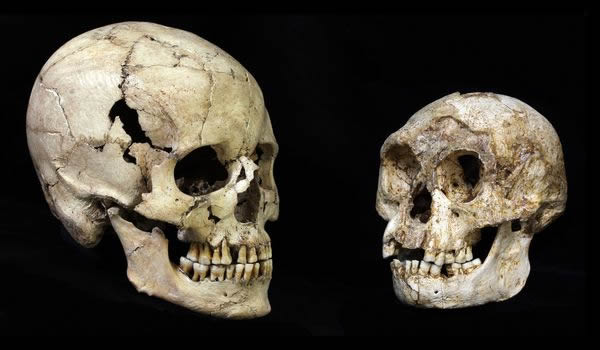Hobbit's Brain Size Holds Clues About Its Ancestor
Diseased ancestor or mini-me? The debate over where the so-called "hobbit," or Homo floresiensis, came from has raged since researchers discovered its remains on the remote Indonesian island of Flores (map) in 2003. Some researchers said its diminutive size was the result of disease, while others believed it descended from a small-bodied human ancestor.
But a new study, published April 17 in the journal Proceedings of the Royal Society B, says that clues to the hobbit-like human's ancestry lies in the size of its brain. The hobbit's gray matter is actually slightly larger than previously thought, according to the study's authors.
The so-called hobbit, which stood three feet (one meter) tall, lived on Flores until approximately 17,000 years ago. Previous studies examining H. floresiensis's skeleton ruled out the possibility of a disease called microcephaly as the cause of its small stature.
But if it was a new species of human, who was its ancestor?
Skulls of Homo sapiens (left) and Homo floresiensis.
Dwarfism?
One possibility is that the hobbit evolved from another small-bodied, small-brained early human, or "hominin," called H. habilis. The main problem with this theory is that there is no evidence that H. habilis ever made it to Southeast Asia, let alone Flores.
Other researchers have argued that H. floresiensis is descended from the larger-bodied H. erectus, widely considered to be the first hominin to leave Africa. Remains of H. erectus have been found throughout Asia, including on the Indonesian island of Java.
According to this hypothesis, H. erectus somehow made its way to Flores, where its descendants shrunk in size through a process called island dwarfism, in which species grow smaller to make the most of limited resources.
"Some recent [animal] examples suggest that island dwarfism may be a fairly rapid process, [occurring] within a few thousand or even a few hundred years, but each case may be different," said study coauthor Yousuke Kaifu, a senior researcher at the National Museum of Nature and Science in Tokyo.
But critics of this theory have argued that the brain size difference between H. erectus and H. floresiensis—991 cubic centimeters (cc) and about 400 cc, respectively—represents an extreme and unprecedented example of island dwarfism. For comparison, modern humans have an average brain size of about 1,300 cc.
"Many recent researchers apparently suppose this is impossible," Kaifu said in an email.
Plausible Differences
But in their new study, Kaifu and his colleagues showed that the size gap is actually smaller than previously thought. Using a new high-resolution CT scanning technique, the team created a 3-D model of an 18,000-year-old H. floresiensis skull and calculated its brain volume to be about 426 cc.
The new estimate is only slightly larger than previous ones, but it makes the idea that H. erectus could have shrunk down to the size of H. floresiensis more plausible, especially if one supposes that the hobbit is descended from an older and smaller form of H. erectus that lived on Java, which had an average brain size of 860 cc.
"The 426 cc figure is interesting because … it becomes possible to explain this brain size entirely by body size reduction from … H. erectus specimens, without invoking further evolutionary or pathological reduction," said Kieran McNulty, an anthropologist at the University of Minnesota who was not involved in the study.
Smaller, But Not Dumber
In addition to measuring the hobbit's brain volume, Kaifu and his team also analyzed 20 different modern human populations, looking at the relationship between their brain size and body size. The team confirmed that the smaller an individual's body is, the smaller his or her brain is in general.
In fact, we "showed that this relationship is actually stronger than previously suggested," Kaifu said. Thus, "much of the brain size reduction from H. erectus to H. floresiensis can be explained by its body size reduction [alone]."
A shrinking brain does not necessarily mean diminished mental abilities, however. Some scientists have suggested that the brain of H. floresiensis underwent "neurological reorganization" as it shrank, so that the brain's functions are largely maintained even as it became smaller.
This could explain why the hobbit was able to use fire and wield stone tools to kill and butcher animals twice their size.
"We commonly associate larger brains with greater intelligence when comparing species," McNulty said in an email. But "the proportions of different parts of the brain and the number and arrangement of connections among those parts are [also] likely critical factors in determining intelligence."
A Third Candidate?
Dean Falk, an anthropologist at Florida State University who was not involved in the research, said Kaifu and his team have made a "compelling case" that the Flores hobbit is descended from H. erectus.
"I'm impressed," said Falk, who in an earlier study concluded that the brain volume of the hobbit was around 417 cc.
However, that research was done using less capable machines and at lower resolutions than the current study, she added.
"Their methods are better. Their machines are better. [So] I'll accept 426 cc instead of 417 cc," Falk said.
The anthropologist noted, however, that the new findings do not rule out the possibility that H. habilis—a smaller-bodied alternative to H. erectus—is the hobbit's ancestor.
Falk also raised a third possibility regarding Flores's mysterious inhabitants: Perhaps the hobbit wasn't descended from a member of the Homo genus at all, but rather was a shrunken member of a far older, and more ape-like, human ancestor known as an australopith that wandered out of Africa long ago.
"You can't rule that out either," she said.
Kaifu and his team agreed that the hobbit's ancestry is far from resolved. "The question," the scientists write in their study, "will be answered most effectively by future discoveries of skeletal evidence for the first hominins to colonize Flores."(Ker Than.for National Geographic News.Published April 18, 2013)












